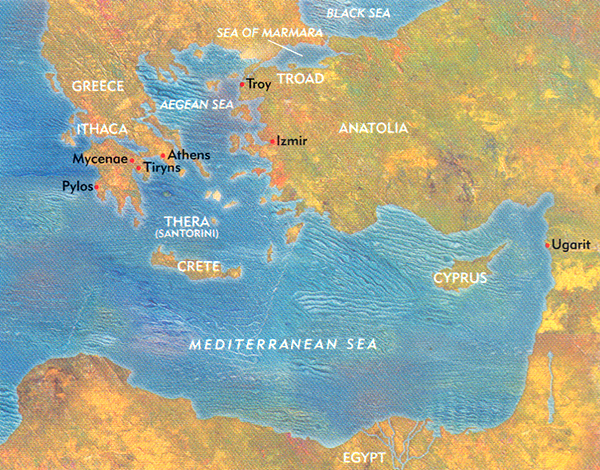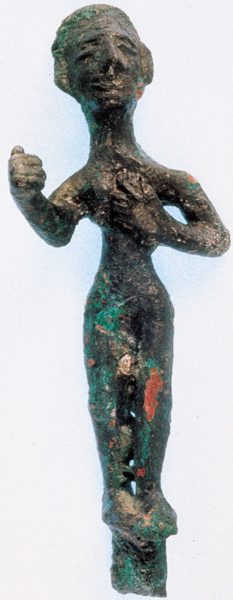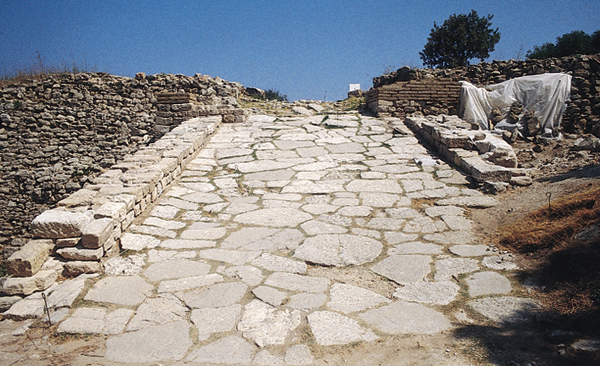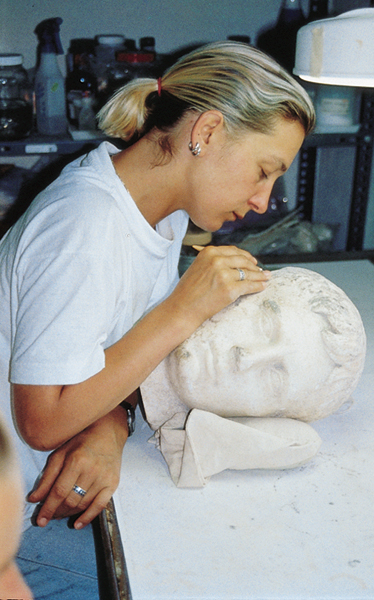
King Agamemnon rose to his feet: “Friends, Zeus vowed to me long ago that I should never embark for home till I had brought the walls of Ilium crashing down.”
“Metal object, biconvex.” Thus wrote English archaeologist Donald Easton in his excavation diary in July 1995, dispassionately recording what every excavator at Troy had previously hoped for in vain. He had discovered the only known example of Bronze Age writing at Troy. It turned out to be a key indicator of the people who lived in the Troy that Homer wrote about.
Archaeologists had long puzzled over why not even a single piece of writing had been found at Late Bronze Age Troy. It was unlikely that the Trojan culture of the time was nonliterate. Without writing, it would have been almost impossible to administer the extensive trade Troy enjoyed with her neighbors. And how could Troy have remained nonliterate while such cultures as Egypt, Canaanite Ugarit, Mycenaean Greece, Hittite Anatolia and Minoan Crete—to choose just several examples—all possessed sophisticated forms of writing?
On the other hand, archaeologists had little hope of discovering a “library” at Troy. The archives from other sites, such as Hattusa (the Hittite capital in central Anatolia), Knossos (the Minoan capital in Crete) and Pylos (a Mycenaean city in Greek Peloponnesus), consist of inscribed clay tablets found in the inner part of a palace or temple area. At Troy, however, exactly this part of the city was razed and built over in Greek and Roman times.
Easton’s prosaic diary entry does not suggest that he found the object insignificant. In the Troy excavations, as elsewhere, metal finds are of the greatest importance—they are passed on directly to restorers, who use extremely fine, dental-like instruments to clean the objects and preserve their surface features. Only when the object is cleaned can the metal be identified, and only then can experts interpret the object.

“I thought it could be a seal and that its material was bronze,” said Easton, describing the moment he first noticed the artifact. “But these were only assumptions, which don’t have any room in the excavation diary. There, only the objective finding is to be noted. And that was a round, biconvex object of metal, a little more than two centimeters in diameter, about one centimeter thick, with holes for a cord. It possibly had engravings. But whether these were really writing could not be distinguished before cleaning. Verdigris and blebs are always a problem with bronze, since they change the structure. Only with the help of a microscope can one identify engravings for sure. Of course, I was curious what the restorers were going to find out.”
For several weeks, what the restorers discovered remained the best kept secret of the Troy excavation team. When Manfred Korfmann, head of the new excavations, presented what indeed turned out to be a seal in a public lecture at Tübingen University in November 1995, whispers of astonishment from the learned audience rustled through the auditorium, for Korfmann announced: “The writing is not—as most of you would have expected—a linear writing. It is not Greek.”

This was a surprise. Every schoolchild knows stories from the ten-year-long battle of Troy: King Agamemnon’s mustering of the Greek chieftains, Achilles’ righteous anger and refusal to fight, the sorrows of Hecuba (wife of Priam, king of Troy) over the deaths of her children, and the cause of it all—the abduction of Helen by Paris, one of Priam’s sons. We all remember Troy’s walls, so mighty that they could only be breeched with the trickery of the horse. After the German-born American citizen Heinrich Schliemann announced in 1871 that he had located the actual Homeric city of Troy on a hill called Hisarlik, in northwestern Asia Minor, nearly everyone assumed that the language of the Late Bronze Age city was Greek.
Until Schliemann, many scholars allowed Troy only a mythological existence. Those who did believe that Troy truly existed tended to situate it five miles south of Hisarlik, near the modern village of Pinarbasi. But Schliemann settled on Hisarlik, cut a huge trench into the mound and found an ancient city—which, he announced to the world, was Homer’s Troy.
Schliemann’s news struck the public like a bombshell. He gave romantic accounts of his search for Troy, using the Iliad as a guide, and dramatically reconstructed the combat scene between Trojan Hector and Greek Achilles. To an enraptured world, Schliemann seemed like a kind of archaeological Columbus.
Unfortunately, neither Schliemann’s story about his discovery of Troy nor his interpretation of what he found quite fit the facts. Schliemann’s attention was drawn to Hisarlik—known as the Greek Ilion and the Roman Ilium—by the Englishman Frank Calvert, whose family had lived in the area for decades, serving as consuls for several western states. Calvert had already located some antique cities of the Troad, the area surrounding Troy; he had even bought the eastern half of the mound of Hisarlik, believing that it, not Pinarbasi, was the site of Troy. But Calvert lacked the funds necessary to excavate the site. When Schliemann, who had made a fortune (mainly as an indigo merchant in St. Petersburg, Russia, and as a gold trader in California), proposed to support the Hisarlik excavation, Calvert gave him every possible encouragement.
Schliemann began as a layman and at first made many mistakes. Since he was convinced that the Homeric town could only be located at the very bottom of the mound, he dug right through, and thus destroyed, much of the upper layers.
In 1873 Schliemann made one of his most stunning discoveries: a rich cache of copper bowls, bronze weapons, gold and silver vessels, silver ingots, and, most spectacular of all, gold jewelry. He promptly identified this hoard as the Treasure of Priam; the magnificent gold pendants in this cache, he claimed, were the Jewels of Helen. (In fact, the treasure dates to the 25th century B.C., more than 1,200 years before the destruction of the Late Bronze Age city associated with the Homeric epics.) Schliemann wasted no time in smuggling the Treasure of Priam out of Turkey and into Greece.


But Schliemann was also learning, by trial and error, more systematic methods of excavation. He deserves credit for being one of the first archaeologists to understand the value of pottery sequencing—dating pottery sherds by comparing them sequentially to other sherds. At Troy, Schliemann also developed a form of stratigraphy, in which the various occupational layers of a site are carefully uncovered one by one (and are dated through pottery sequences). Despite his faults, Schliemann laid the foundations on which his successors could continue the work after he died suddenly, of complications related to an ear operation, in 1890. It was left to his successors to uncover Troy’s extensive remains.a
For archaeologists, the most reliable information comes from excavating and studying undisturbed occupation layers. But undisturbed, unmixed occupation levels are seldom found at Troy. For more than 3,500 years, one new settlement after another was erected directly on top of the previous one, almost always following a different ground plan. Over the years the mound grew by almost 65 feet—a huge layer-cake of occupation levels. But this mound has been gouged and disturbed over and over again. Schliemann’s early unsystematic excavations are only one instance. A number of earthquakes destroyed Troy’s occupational levels; and there was a great deal of leveling and rebuilding in Hellenistic and Roman times. In constructing the great Temple of Athena in the third century B.C., for example, the Greeks simply cleared away a large area in the center of the city. Even more drastic were the renovations made by the Romans when they extended the sanctuary after 85 B.C.
Despite these obstacles, Troy’s history has been pried open layer by layer.
As far back as the early Bronze Age, Troy engaged in extensive trade. The city sat at the entrance to the Dardanelles—the narrow straits connecting the Aegean Sea and the Sea of Marmara, which lead into the Black Sea through the Bosporus—and thus came to serve as a central entrepôt for trade with lands on the Black Sea and to the east. What made Troy’s position so powerful was the wind. At the entrance to the Dardanelles, a strong wind prevails from the northeast; in addition, a powerful 5-knot surface current flows from the Sea of Marmara into the Aegean Sea. Thus the flat-bottomed, square-rigged ships of the Bronze Age had to lay up at Troy and wait for favorable southerly winds, which blow for only a few days in the summer.
The Trojans were thus able to charge not only tolls for passage through the Dardenelles but also mooring fees. Because of the city’s location, much business was transacted at Troy; goods were exchanged; ships unloaded and reloaded. The city became an important trade center between east and west and, in the late Bronze Age, between north and south, too.
Troy’s earliest settlers arrived around 2920 B.C. (Troy I). So advantageous was the site’s location at the head of the Dardenelles that the hill of Hisarlik was occupied for over 4,000 years. It was finally abandoned in the 14th century A.D., after a Christian bishopric that had been established there was dissolved. Only a few centuries thereafter, Troy fell so completely into obscurity that many scholars were convinced that it had existed only in myth.
Far and away the richest Trojan city was Troy VI (1700–1250/30 B.C.). This city became important for trade and for producing pottery and wool, as well as for breeding horses. Around 1470 B.C.—using only Bronze Age tools—the Trojans erected the mighty walls and towers whose ruins still astound us today.
Until a few years ago, it was thought that these walls were the defense system of the whole city. Some scientists were astonished that the fortifications of the powerful Bronze Age city encompassed only about five acres. Korfmann’s excavations since 1988 have provided an answer to this problem: These impressive fortifications enclosed only Troy’s citadel, while the city itself lay to the south and was at least nine times as large.
This lower city also had an ingenious defense system. The most devastating weapon of the Late Bronze Age was the horse-drawn war chariot. With chariots, warriors could quickly move to different attack points and archers could swiftly change position and crush the enemy with driving runs. It was crucial for survival that enemy chariots be kept at a distance. The Trojans developed a simple, effective solution: Into the relatively soft bedrock they cut a ditch, which on the city side was slightly beveled. This ditch was just wide and deep enough to stop chariots from getting over it, so that attackers had to dismount and penetrate on foot, climbing in full sight the sloped side of the ditch in their heavy armor. Approximately 300 feet behind the ditch, the Trojans built a rampart from which they defended the lower city. From there, Troy’s archers could take free aim at their armor-encumbered attackers. Only parts of this rampart have been excavated so far: the foundations of an almost 10-foot-thick wooden palisade (probably consisting of a line of stakes in front of a platform) from early Troy VI and a massive mudbrick wall on a stone foundation from late Troy VI. According to Korfmann, the mudbrick wall, found in 1995, and the palisade show conclusively that the lower city had been planned from the beginning, and that Troy’s residents—other than, perhaps, royalty and priests—had always lived outside the citadel area.
At some point between 1250 and 1230 B.C. life in Troy changed drastically. The palaces in the citadel area were destroyed and in their place smaller buildings were constructed. This indicates that in this period class distinctions (between royalty or priests and common people, for example) no longer determined who lived in the citadel and who lived in the lower city. Exactly what happened at this time is still under discussion. However, the pottery from this period is of the same style as that from the earlier, more prosperous period—so it is certain that there was no change of occupancy. Therefore, the destruction may have occurred in a number of ways: as a result of an earthquake, an attack from outside, social upheaval, a conflagration or—most likely—a combination of these factors.
At the same time, the whole eastern Mediterranean region was becoming destabilized. Trade had declined, and a few decades later Mycenaean and Hittite cities lay in ruins, their great empires destroyed. Troy remained occupied, but it never recovered its former splendor. When the city was attacked around 1180 B.C., it could not defend itself and fell victim to a devastating inferno. In the 1995 excavation season, convincing evidence was found to show that this fire preceded a war, a war that the Trojans lost.
The date of this war, around 1180 B.C., was determined by such scientific methods as radiocarbon analysis and pottery seriation. This date corresponds with ancient Roman and Egyptian sources that date Homer’s Trojan War one year before the destruction of the Phoenician city of Sidon—which occurred, according to the latest research, shortly before 1180/1179 B.C.
The war did not mean the end of Troy, or the expulsion of the old population. But the city was now ruled by another people, whose pottery was less artistic than that of the previous occupants. Less than 50 years later, new immigrants again arrived, this time from the Balkans. They quickly adopted certain techniques from the native Trojans (for example, the use of the pottery wheel) and carried on, albeit to a lesser degree, trade with the regions west of the Aegean. Until shortly after 1000 B.C., these three peoples—the old Trojans, the people who arrived in the first half of the 12th century B.C. and the Balkan people—lived together in Troy; thereafter, according to the archaeological evidence, the city was sparsely populated but not completely deserted for about 250 years.
But who exactly were the inhabitants of the Late Bronze Age city of Troy VI? For 124 years, most scholars assumed that they were Greeks, like the Mycenaeans, and that they spoke the Greek language spoken by the Mycenaeans. The pottery indicates a lively trade between Troy and Greece at this time. But no written document giving conclusive answers had been uncovered.
That all changed with Donald Easton’s 1995 discovery of the bronze seal—the “metal object, biconvex”: The characters that it bears are not in the Linear B script used by the Mycenaeans. Rather, the text—part of the name of a scribe and of a woman, probably his wife—is written in Hittite hieroglyphs. These characters were used to write Luwian, an Indo-European language closely related to Hittite.b
This indicates that Late Bronze Age Troy did not belong to the Mycenaean-Greek but to the Hittite-Luwian culture. There is additional evidence to support this conclusion. The gates and the defensive ditch resemble Hittite, rather than Mycenaean, architecture. That Troy was not Mycenaean is supported by ceramic evidence as well: Modern statistical analysis, with the help of computers, has shown that only a small fraction of Bronze Age Trojan pottery is stylistically Mycenaean—some imported from abroad and some produced locally. The vast majority of Trojan pottery is indigenous, especially the so-called Grey Minyan Ware.

During the 1996 excavation season, archaeologists also found a new explanation for the many stelae that can still be seen at the gates of Troy VI: They were used in the worship of the city’s main deity, probably the god Appaliunas. In the Late Bronze Age, stelae like these are known so far only from sites further east—in Hittite and Luwian Anatolia—not along the Aegean Sea.
In the 1995 season, archaeologists unearthed what they call a Standing Warrior—a small bronze figure of a god—of a type also found at Hittite and other Near Eastern sites. These parallels clearly reflect the close links between the Trojans at the end of the Late Bronze Age and the Hittite-Luwian world.
Given this evidence, it is becoming increasingly likely that the city Homer called Troy or Ilios (in early Greek it is written “Wilios”) was a Luwian city, known by the Hittites as Wilusa. This thesis is also substantiated by recently found Hittite texts, whose geographical details suggest that Wilusa was located in northwestern Anatolia, that is, in the Troad.
There is more: In a Hittite vassal treaty of about 1280 B.C., between the Hittite king Muwatalli and King Alaksandu of Wilusa, three gods are named as witnesses for Wilusa: (1) Appaliunas, (2) the “Storm God of the Army” and (3) (Dingir)Kaskal.Kur. The names “Alaksandu” and “Appaliunas” closely resemble names connected with Troy in the Iliad—another name for Paris in the Iliad is Alexandros, and the patron god of the Trojans is Apollo. Many scholars think that the god Apollo was of Anatolian origin; and in Greek times, Apollo was represented on city gates in stelae—like those found at Late Bronze Age Troy.
The campaign of 1997 also confirmed the possibility that Troy and Wilusa are identical: (Dingir)Kaskal.Kur, the third god named as a witness to the 1280 B.C. treaty, literally means “[god of] the Underground River.” This god was presumably associated with the underworld in general and with wells and water in particular. For his cult, the Hittites built artificial caves next to a holy lake in their capital, Hattusa. Just such an artificial well-cave with three branches was identified in Troy during the past season’s excavations. This means that the cults of at least two of the three gods named for Wilusa existed at (W)ilios/Troy.
Hittite documents record several conflicts, possibly even wars, involving Wilusa. A line from a 16th-century B.C. Luwian cult song shows astonishing parallels with Homer. In the Iliad, Homer refers to “steep Ilios”; the Luwian line reads either “When they came from steep Wilusa” or “When they came from Wilusa on the sea.” Did Homer know of this Wilusiad? Was it possibly one of his models? The man we call Homer, who put the Iliad into its final form, lived in the eighth century B.C.—in or around today’s Izmir, in modern Turkey. There, in Homer’s day, the Luwian language was still spoken and understood. And that could mean that the Iliad is based not only on oral history but also on written sources.
So was Homer’s Troy also Mycenaean Greek? Or was it solely Hittite? Perhaps it was a third entity, a Luwian place of its own, mediating between mighty neighbors to the east and west, translating for them, exchanging not only goods but news, technologies and ideas. Many cities on national borders share the characteristics of both sides; Strasbourg, for example, represents French lifestyles in German buildings. In this same way, mighty Troy VI functioned as a kind of melting pot, a little Late Bronze Age Manhattan, where people went to exchange ideas and inventions, which they then brought home.

Europe came from Asia, according to a Greek legend: Writing and numbers, bronze and iron, religion and philosophy, and much more are of oriental origin. In the Greek myth, Zeus kidnaps Europa and flees with her to the island of Crete—not the shortest route to Europe. The mightiest of the Olympian gods was not stupid; so I think that the myth got it wrong. Zeus and Europa must have journeyed to the European mainland via Troy, as did so many others.
This article is based on the research of the team from Tübingen University and the University of Cincinnati and other scientists. Without their help, I would not have been able to write extensive text on the subject. The excavation results are published annually in Studia Troica. Readers who wish to support archaeological work in the Troad are invited to join the Friends of Troy, Prof. Getzel M. Cohen, Institute for Mediterranean Studies, 7086 East Arcoma Drive, Cincinnati, OH 45237.
MLA Citation
Footnotes
Schliemann’s assistant, Wilhelm Dörpfeld, a German architect, identified Troy’s nine basic strata—a scheme archaeologists continue to follow today. He completed his excavations in 1894. From 1932 to 1938, Carl Blegen, sponsored by the University of Cincinnati, used highly refined excavation methods to differentiate 46 separate construction phases (or sub-strata) at Troy. Blegen’s most famous finds were a large palace from Troy VI (the so-called Pillar House) and a Greek-Roman sanctuary. The current excavations, begun in 1988, are directed by Manfred Korfmann of Tübingen University.
Luwian-speaking peoples came into Anatolia in the third millennium B.C., about the same time as the Hittites. They settled mainly in the south and west and founded several kingdoms—the most important being Kizzuwatna in the southeast (roughly equivalent to Cilicia in later years) and Arzawa in the west (the region surrounding Ephesus). The Luwians were at different times allies, rivals and vassals of the Hittites. Since their languages were about as closely related as modern Dutch and German, there was a good deal of cultural exchange between the two peoples, especially between Kizzuwatna and Hatti (as the Hittites called their territory in central Anatolia).








